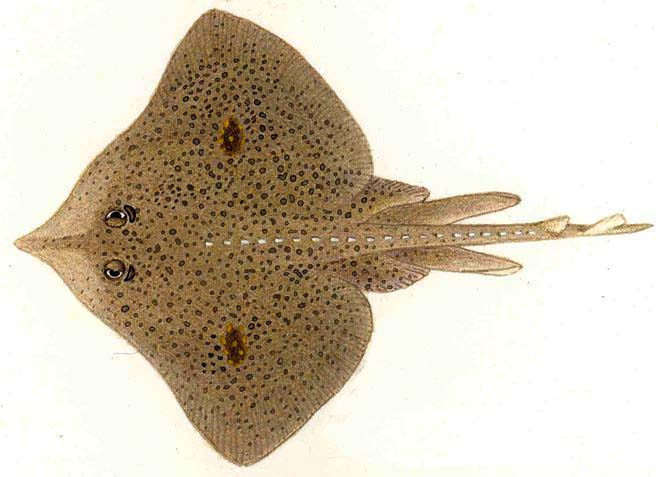|
Raja straeleni (Biscuit skate)
Poll, 1951
Life
> Eukaryotes >
Opisthokonta
> Metazoa (animals) >
Bilateria >
Deuterostomia > Chordata >
Craniata > Vertebrata (vertebrates) > Gnathostomata (jawed
vertebrates) > Chondrichthyes > Elasmobranchii > Batoidei >
Rajoidei > Rajidae
 |
|
Raja straeleni (Biscuit skate) [Illustration
by Ann Hecht ©] |
Identification
A brown, black-spotted skate with a blunt,
angular snout, broad angular disk, long stout tail, strong thorns on
upper surface of disk and tail at all stages, sometimes on underside
in large individuals. Colour medium brown or grey-brown, usually
with small to large black spots, whorls, and blotches; many
individuals with a gold and black, transversely oblong eyespot on
each pectoral base. Underside of disk white, no dark pores.
Size
To
91 cm TL and 68 cm DW.
Range
West and southeast coast, central
Namibia to Algoa Bay and perhaps Natal; tropical west Africa.
Habitat
Close inshore in shallow enclosed bays to upper slope at
353 m deep on the uppermost continental slope, down to 690 m off
west Africa.
Biology
Extremely common. Eats shrimp, mysids, hermit
crabs, mantis shrimp, crabs, squid, bony fish including hake,
ribbonfish, sardine, redeye herring, dragonets, lanternfish, and
lightfish, and fish offal.
Human Impact
Caught by shore and skiboat
anglers inshore, but most commonly taken by bottom trawlers on the
hake grounds. The pectoral fins of biscuit skates are marketed as
`skate wings' for human consumption.
NOTE:
The very similar European
thornback skate (Raja clavata) has been reported from the area, but
its status here is uncertain.****
Text by Leonard J.V. Compagno, David A. Ebert
and Malcolm J. Smale
|
